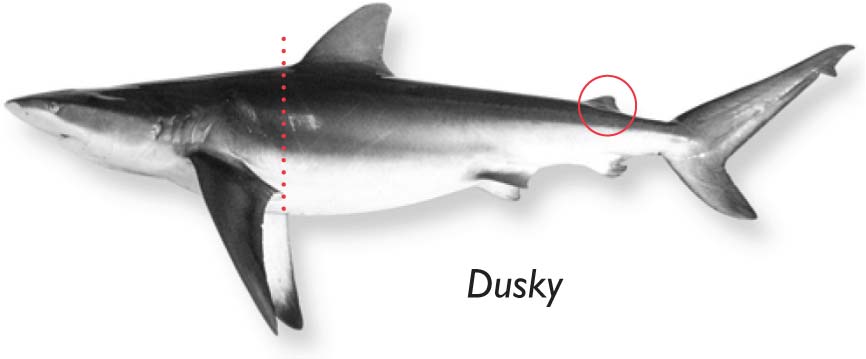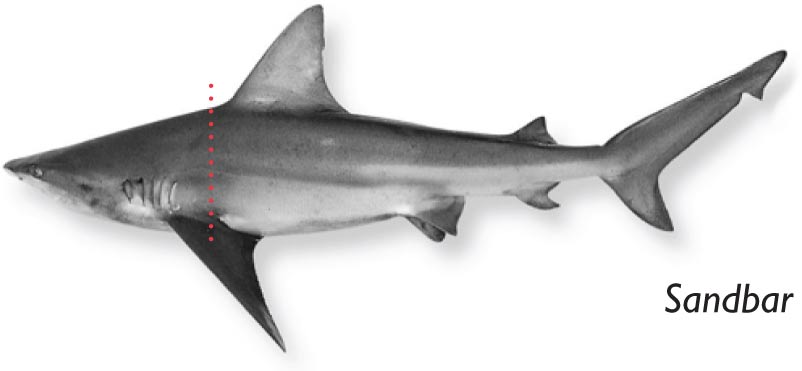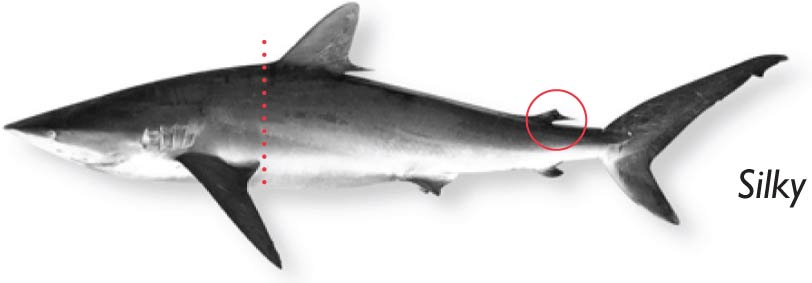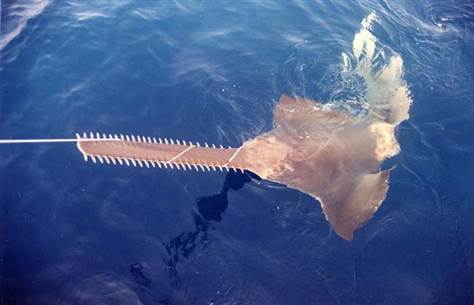Prohibited Shark Species
Similar Species and Distinguishing Characteristics
The following species may not be retained (zero bag limit) and must be released immediately without removing them from the water.
If you catch a shark and are unsure of the species identification, release it.
- Atlantic Angel
- Flat skate-like body; large spiracles behind eyes; two small dorsal fins located near the tail
- Basking
- Has enormous gill slits nearly encircling head; maximum size about 32 feet; no similar species; rare in Texas waters
- Bigeye Sand Tiger
- Similar to sand tiger; similar to lemon shark but has first dorsal fin far back on body closer to pelvic fins than pectoral fins; similar to nurse shark but has a distinct lower lobe on caudal fin; rare in Texas waters
- Bigeye Sixgill
- Has six gill slits; similar only to sixgill; rare in Texas waters
- Bigeye Thresher
- Upper lobe of caudal fin extremely long and about half of total body length; similar to thresher but has large eyes directed upward, deep grooves on top of the head, and white abdominal coloring that does not extend above pectoral fins; rare in Texas waters
- Bignose
- Similar to silky and dusky but has first dorsal fin originating over pectoral fin insertion; similar to sandbar but has longer snout; similar to blacktip and bull but has interdorsal ridge; rare in Texas waters

- Caribbean Reef
- Similar to blacktip but has interdorsal ridge; similar to sandbar but has first dorsal fin originating behind the pectoral fins; similar to dusky, silky and Galapagos but has a much shorter free rear tip of the second dorsal fin.
- Caribbean Sharpnose
- Similar to Atlantic sharpnose but is rare in Texas waters
- Dusky
- Similar to bull, blacktip and spinner but has interdorsal ridge; similar to sandbar but has sloping first dorsal fin origination over or slightly before free tips of pectoral fins; similar to silky but length of second dorsal fin free tip rarely more than twice the fin height

- Galapagos
- Similar to grey reef and dusky but is rare in Texas waters.
- Longfin Mako
- Similar to shortfin mako but has dusky or bluish-black mouth area and long broad tipped pectoral fins; similar to blue shark but has caudal keel; rare in Texas waters
- Narrowtooth
- Similar to blacktip and spinner but has distinctive narrow triangular upper teeth and a slight arch to the back above the gill slits
- Night
- Similar to silky and dusky but has large green eyes; similar to spinner and blacktip but has small dorsal fin and interdorsal ridge; rare in Texas waters
- Oceanic Whitetip
- Broadly rounded white-tipped first dorsal fin
- Sandbar
- Similar to dusky but has large first dorsal fin originating over or slightly before pectoral insertion; similar to bull, blacktip and spinner but has interdorsal ridge

- Sand Tiger
- Similar to bigeye sand tiger; similar to lemon shark but has first dorsal fin far back on body closer to pelvic fins than pectoral fins; similar to nurse shark but has a distinct lower lobe of caudal fin

- Sevengill
- Has seven gill slits; no similar species
- Shortfin Mako
- Similar to longfin mako but underside of snout and mouth are white; similar to blue shark but has caudal keel
- Silky
- Similar to bull, blacktip and spinner but has interdorsal ridge; similar to sandbar but has dorsal fin originating behind pectoral fins; similar to dusky but length of second dorsal fin free tip usually more than twice the fin height

- Sixgill
- Has six gill slits; similar only to bigeye sixgill
- Smalltail
- Has deeply notched anal fin and short gill openings; no similar species
- Whale
- Unique pattern of light spots and stripes; maximum size about 40 feet; no similar species
- White
- Similar to mako sharks but has large triangular serrated teeth
Interdorsal ridge is a distinctive, raised strip found along the midline of the back between the dorsal fins.
Sawfish Prohibitions
All sawfish species are endangered and are protected by the Endangered Species Act. As a result, it is illegal to target, take, kill, or disturb any sawfish. If a sawfish is unintentionally caught, please use sawfish safe release guidelines and report all encounters to the National Sawfish Encounter Database.
- Email:
- sawfish@flmnh.ufl.edu
- Phone:
- (352) 392-2360
- Web:
- www.flmnh.ufl.edu/fish/sharks/sawfish
